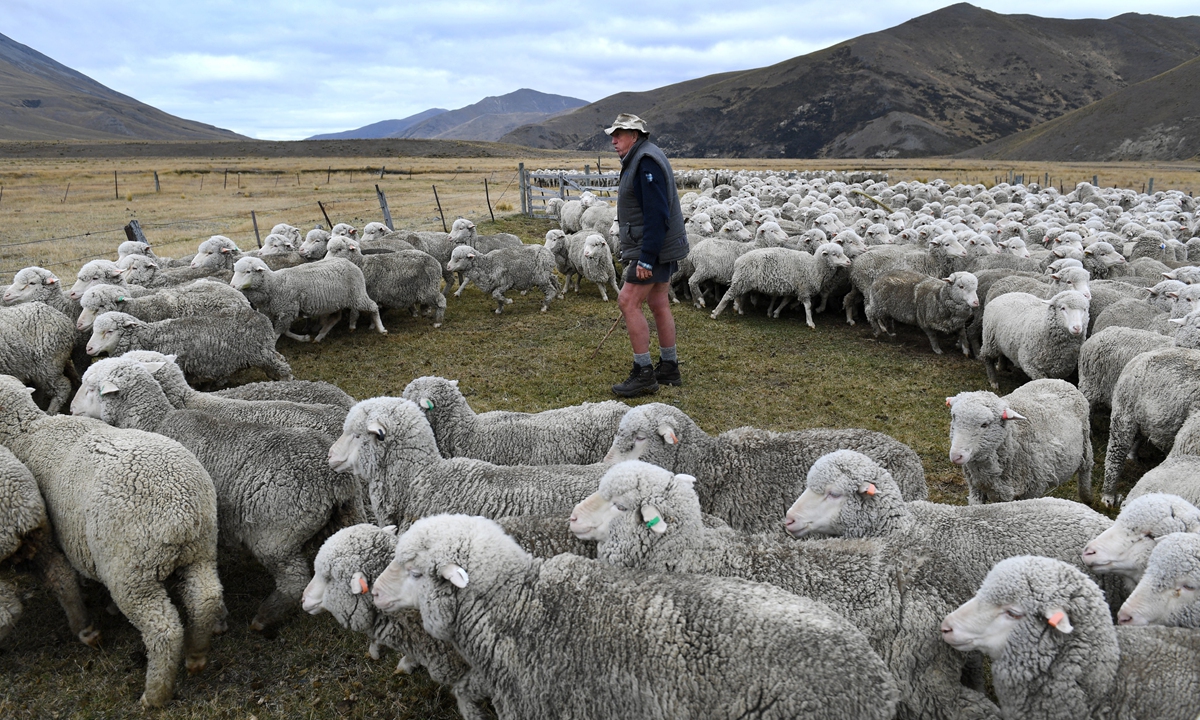
Farmer Tim Innes herds merino sheep into the yards for drenching during a two-day muster on the 30,000 acre (12,140 hectares) Dunstan Downs sheep station at Lindis Pass, deep in New Zealand's South Island. File photo: AFP
Famous for its lamb, New Zealand's agricultural industry was once so well-subsidized that slaughterhouse workers were said to earn more than airline pilots, recalled William Rolleston, a farmer in South Canterbury and leading advocate for the sector.
A few decades ago, huge subsidies meant vast swathes of the country's marginal land was cleared for grazing, fertilizer was overused, and the sheep population boomed to the point where surplus meat had to be destroyed.
Across New Zealand, the subsidy programs took a toll on nature, polluting rivers and eroding soils, according to a study by the UN Convention on Biological Diversity (CBD).
Then, in 1984, there was "total upheaval," Rolleston said.
In a radical shift, the subsidies were removed or phased out. Farming became more efficient while harmful practices decreased: Fertilizer use declined by 50 percent and many farmers' hillsides were reforested, according to the CBD's report.
While agriculture remains a major source of the country's planet-warming greenhouse gas emissions, New Zealand is still held up by biodiversity campaigners as a "poster child" for reforming subsidies that harm nature and the environment.
The issue is expected to feature at the United Nations COP15 summit where countries will try to agree on a framework to protect biodiversity.
The latest draft agreement includes a target to reform at least $500 billion of harmful subsidies annually across sectors including agriculture.
Around the world, government subsidies that harm nature amount to at least $1.8 trillion each year - equivalent to 2 percent of global GDP - according to a study published in February by the Business for Nature advocacy group.
It said agriculture subsidies - at $520 billion annually - are the largest drivers of ecosystem destruction, along with those for fossil fuels - at $640 billion - which have a more indirect impact on biodiversity, mainly through climate change.
Concerns are growing over the world's ability to control climate change and halt temperature rise, with a recent World Wildlife Fund (WWF) report showing that nature has absorbed 54 percent of human-related carbon dioxide emissions over the last decade.
Agricultural subsidies for things like meat production and fertilizers are also considered a threat to long-term food security.
A decrease in fertile soil means 95 percent of land worldwide could become degraded by 2050, according to the Global Environment Facility, a multilateral fund.
Decision-makers are "counting on" subsidy reforms to close the majority of the financing gap for biodiversity protection - estimated at $700 billion each year - said Brian O'Donnell, director of the conservation nonprofit Campaign for Nature.
"That is, in my mind, a very risky proposition," O'Donnell said, adding that it will require global political shifts for these funds to be accessed and repurposed. "It means that governments have to truly commit to this rapidly."
The issue has been gaining momentum, including support from the Group of Seven (G7) wealthy nations, reforms to the European Union's Common Agricultural Policy (CAP) subsidies program, and a World Trade Organization deal to prohibit harmful fishery subsidies.
However, O'Donnell said there had been several subsidy agreements in the past - including at UN biodiversity talks in 2010 - but overall progress was "minimal at best."
One of the attractions of subsidy reform for governments is that it involves repurposing existing funds rather than having to come up with new money at a time when budgets are stretched.
But these subsidies are complex, consisting of various tools such as payments based on agricultural production, minimum price guarantees for goods, and income support for farmers.
The first thing nations must do is to assess and understand the full extent of their subsidies and their impacts on nature, said Martina Fleckenstein, head of food policy at WWF International.
"We know where we want to go. The challenge is how does it look at the national level?" she said.
Analysts say a major reason reform can be so difficult is that many powerful interests are beneficiaries of subsidies.
Agricultural subsidies tend to disproportionately favor large farms at the expense of small farmers, according to research by the World Resources Institute (WRI) think tank.
"Most of this is around domestic politics and dealing with strong domestic constituencies," said Andrew Deutz, director of policy and finance at conservation group The Nature Conservancy.
He said the politics around agriculture should be different to fossil fuels, though, because subsidies need to be repurposed to incentivize positive practices instead of being pulled out of the sector completely.
Whatever new agricultural initiatives are brought in to preserve nature, experts say such changes do not occur overnight - and that those in the agricultural sector will need support to adapt.
"You need to have coping strategies, it's not like silver bullets resolve all the problems," said Helen Ding, a senior economist and subsidies expert at WRI.
Farmers need to be reassured that they can sustain their incomes and support their families while implementing practices which protect nature, she added.
In Costa Rica, for example, she spoke to farmers who were growing organic coffee on a portion of their land alongside conventional production, to insure against fluctuations in yields and the international coffee trade.
In New Zealand, Rolleston said farmers in the 1980s were in favor of the subsidy reforms, but still needed support to adapt their practices.
Reuters














评论